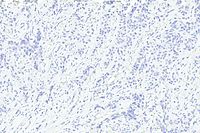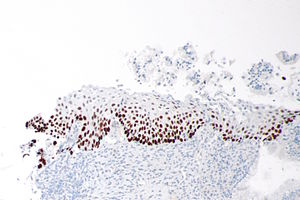Difference between revisions of "P63"
Jump to navigation
Jump to search

| (7 intermediate revisions by the same user not shown) | |||
| Line 6: | Line 6: | ||
| Abbrev = | | Abbrev = | ||
| Synonyms = | | Synonyms = | ||
| Similar = p40 (more specific for squamous cell carcinoma) | | Similar = [[p40]] (more [[specificity|specific]] for squamous cell carcinoma) | ||
| Clones = | | Clones = | ||
| Use = breast pathology (invasion vs. in situ), prostate pathology (HGPIN vs. cancer), lung (adenocarcinoma vs. squamous) | | Use = breast pathology (invasion vs. in situ), prostate pathology (HGPIN vs. cancer), lung (adenocarcinoma vs. squamous) | ||
| Line 19: | Line 19: | ||
==Pattern== | ==Pattern== | ||
*Nuclear staining. | *Nuclear staining. | ||
*Stains basal cells in a normal squamous epithelium. | |||
**Superficial cells are typically negative. | |||
**In dysplasia, the staining is seen more superficially,<ref name=pmid19700941>{{Cite journal | last1 = Houghton | first1 = O. | last2 = McCluggage | first2 = WG. | title = The expression and diagnostic utility of p63 in the female genital tract. | journal = Adv Anat Pathol | volume = 16 | issue = 5 | pages = 316-21 | month = Sep | year = 2009 | doi = 10.1097/PAP.0b013e3181b507c6 | PMID = 19700941 }}</ref> as one might expect as most squamous carcinomas are positive for p63. | |||
Note: | Note: | ||
*Cytoplasmic staining suggestive of muscle differentiation - seen in [[rhabdomyosarcoma]].<ref name=pmid21623385>{{Cite journal | last1 = Martin | first1 = SE. | last2 = Temm | first2 = CJ. | last3 = Goheen | first3 = MP. | last4 = Ulbright | first4 = TM. | last5 = Hattab | first5 = EM. | title = Cytoplasmic p63 immunohistochemistry is a useful marker for muscle differentiation: an immunohistochemical and immunoelectron microscopic study. | journal = Mod Pathol | volume = 24 | issue = 10 | pages = 1320-6 | month = Oct | year = 2011 | doi = 10.1038/modpathol.2011.89 | PMID = 21623385 }}</ref> | *Cytoplasmic staining suggestive of muscle differentiation - seen in [[rhabdomyosarcoma]].<ref name=pmid21623385>{{Cite journal | last1 = Martin | first1 = SE. | last2 = Temm | first2 = CJ. | last3 = Goheen | first3 = MP. | last4 = Ulbright | first4 = TM. | last5 = Hattab | first5 = EM. | title = Cytoplasmic p63 immunohistochemistry is a useful marker for muscle differentiation: an immunohistochemical and immunoelectron microscopic study. | journal = Mod Pathol | volume = 24 | issue = 10 | pages = 1320-6 | month = Oct | year = 2011 | doi = 10.1038/modpathol.2011.89 | PMID = 21623385 }}</ref> | ||
== | ==Staining== | ||
===Positive - common use=== | |||
*Marker of [[squamous cell carcinoma]]. | *Marker of [[squamous cell carcinoma]]. | ||
*[[Urothelial carcinoma]].<ref name=pmid15976812>{{Cite journal | last1 = Lewis | first1 = JS. | last2 = Ritter | first2 = JH. | last3 = El-Mofty | first3 = S. | title = Alternative epithelial markers in sarcomatoid carcinomas of the head and neck, lung, and bladder-p63, MOC-31, and TTF-1. | journal = Mod Pathol | volume = 18 | issue = 11 | pages = 1471-81 | month = Nov | year = 2005 | doi = 10.1038/modpathol.3800451 | PMID = 15976812 | URL = http://www.nature.com/modpathol/journal/v18/n11/full/3800451a.html}}</ref> | *[[Urothelial carcinoma]].<ref name=pmid15976812>{{Cite journal | last1 = Lewis | first1 = JS. | last2 = Ritter | first2 = JH. | last3 = El-Mofty | first3 = S. | title = Alternative epithelial markers in sarcomatoid carcinomas of the head and neck, lung, and bladder-p63, MOC-31, and TTF-1. | journal = Mod Pathol | volume = 18 | issue = 11 | pages = 1471-81 | month = Nov | year = 2005 | doi = 10.1038/modpathol.3800451 | PMID = 15976812 | URL = http://www.nature.com/modpathol/journal/v18/n11/full/3800451a.html}}</ref> | ||
*[[Small cell carcinoma of the lung]] ~80% of cases.<ref name=pmid15551738>{{Cite journal | last1 = Au | first1 = NH. | last2 = Gown | first2 = AM. | last3 = Cheang | first3 = M. | last4 = Huntsman | first4 = D. | last5 = Yorida | first5 = E. | last6 = Elliott | first6 = WM. | last7 = Flint | first7 = J. | last8 = English | first8 = J. | last9 = Gilks | first9 = CB. | title = P63 expression in lung carcinoma: a tissue microarray study of 408 cases. | journal = Appl Immunohistochem Mol Morphol | volume = 12 | issue = 3 | pages = 240-7 | month = Sep | year = 2004 | doi = 10.1097/00129039-200409000-00010 | PMID = 15551738 }}</ref> | |||
===Invasive versus in situ=== | |||
Thresholding (invasive vs. pre-invasive): | Thresholding (invasive vs. pre-invasive): | ||
*Prostate basal cell marker. | *Prostate basal cell marker. | ||
*Breast myoepithelial cell marker. | *Breast myoepithelial cell marker. | ||
===Negative=== | |||
[[Image:Poorly differentiated carcinoma -- p63 - intermed mag.jpg|thumb|right|200px|Negative p63 staining in a poorly differentiated [[carcinoma]].]] | |||
*[[Malignant mesothelioma]].<ref name=pmid18064689>{{Cite journal | last1 = Pu | first1 = RT. | last2 = Pang | first2 = Y. | last3 = Michael | first3 = CW. | title = Utility of WT-1, p63, MOC31, mesothelin, and cytokeratin (K903 and CK5/6) immunostains in differentiating adenocarcinoma, squamous cell carcinoma, and malignant mesothelioma in effusions. | journal = Diagn Cytopathol | volume = 36 | issue = 1 | pages = 20-5 | month = Jan | year = 2008 | doi = 10.1002/dc.20747 | PMID = 18064689 }}</ref> | |||
*[[Breast carcinoma]]. | |||
*[[Prostatic carcinoma]]. | |||
==Non-classic tumours== | ==Non-classic tumours== | ||
Revision as of 22:13, 13 December 2019
| P63 | |
|---|---|
| Immunostain in short | |
 p63 staining in squamous epithelium with dysplasia. | |
| Similar stains | p40 (more specific for squamous cell carcinoma) |
| Use | breast pathology (invasion vs. in situ), prostate pathology (HGPIN vs. cancer), lung (adenocarcinoma vs. squamous) |
| Normal staining pattern | nuclear staining |
| Positive | squamous cell carcinoma, urothelial carcinoma |
| Negative | prostate carcinoma, most lung adenocarcinoma, breast carcinoma |
p63 is a commonly used immunostain. p63, like most other "p" stains, is a nuclear stain.
Pattern
- Nuclear staining.
- Stains basal cells in a normal squamous epithelium.
- Superficial cells are typically negative.
- In dysplasia, the staining is seen more superficially,[1] as one might expect as most squamous carcinomas are positive for p63.
Note:
- Cytoplasmic staining suggestive of muscle differentiation - seen in rhabdomyosarcoma.[2]
Staining
Positive - common use
- Marker of squamous cell carcinoma.
- Urothelial carcinoma.[3]
- Small cell carcinoma of the lung ~80% of cases.[4]
Invasive versus in situ
Thresholding (invasive vs. pre-invasive):
- Prostate basal cell marker.
- Breast myoepithelial cell marker.
Negative

Negative p63 staining in a poorly differentiated carcinoma.
Non-classic tumours
- Di Como et al[6] looked at a large cross-section of tumours.
- Jo and Fletcher[7] did a paper on soft tissue lesions and p63.
See also
References
- ↑ Houghton, O.; McCluggage, WG. (Sep 2009). "The expression and diagnostic utility of p63 in the female genital tract.". Adv Anat Pathol 16 (5): 316-21. doi:10.1097/PAP.0b013e3181b507c6. PMID 19700941.
- ↑ Martin, SE.; Temm, CJ.; Goheen, MP.; Ulbright, TM.; Hattab, EM. (Oct 2011). "Cytoplasmic p63 immunohistochemistry is a useful marker for muscle differentiation: an immunohistochemical and immunoelectron microscopic study.". Mod Pathol 24 (10): 1320-6. doi:10.1038/modpathol.2011.89. PMID 21623385.
- ↑ Lewis, JS.; Ritter, JH.; El-Mofty, S. (Nov 2005). "Alternative epithelial markers in sarcomatoid carcinomas of the head and neck, lung, and bladder-p63, MOC-31, and TTF-1.". Mod Pathol 18 (11): 1471-81. doi:10.1038/modpathol.3800451. PMID 15976812.
- ↑ Au, NH.; Gown, AM.; Cheang, M.; Huntsman, D.; Yorida, E.; Elliott, WM.; Flint, J.; English, J. et al. (Sep 2004). "P63 expression in lung carcinoma: a tissue microarray study of 408 cases.". Appl Immunohistochem Mol Morphol 12 (3): 240-7. doi:10.1097/00129039-200409000-00010. PMID 15551738.
- ↑ Pu, RT.; Pang, Y.; Michael, CW. (Jan 2008). "Utility of WT-1, p63, MOC31, mesothelin, and cytokeratin (K903 and CK5/6) immunostains in differentiating adenocarcinoma, squamous cell carcinoma, and malignant mesothelioma in effusions.". Diagn Cytopathol 36 (1): 20-5. doi:10.1002/dc.20747. PMID 18064689.
- ↑ Di Como, CJ.; Urist, MJ.; Babayan, I.; Drobnjak, M.; Hedvat, CV.; Teruya-Feldstein, J.; Pohar, K.; Hoos, A. et al. (Feb 2002). "p63 expression profiles in human normal and tumor tissues.". Clin Cancer Res 8 (2): 494-501. PMID 11839669.
- ↑ Jo, VY.; Fletcher, CD. (Nov 2011). "p63 immunohistochemical staining is limited in soft tissue tumors.". Am J Clin Pathol 136 (5): 762-6. doi:10.1309/AJCPXNUC7JZSKWEU. PMID 22031315.